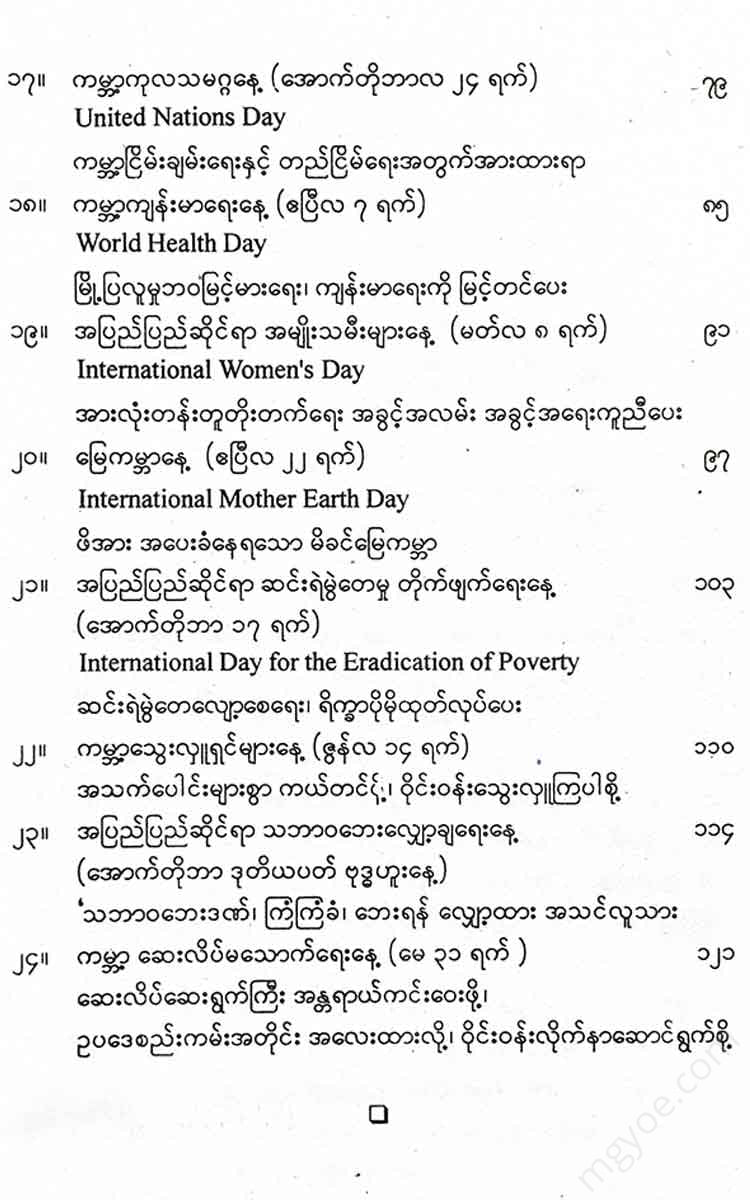စိတ်ကူးချိုချိုစာပေ
Phyo Thar - Contestant Commemoration Day Essays
Phyo Thar - Contestant Commemoration Day Essays
Couldn't load pickup availability
Countries around the world celebrate World Population Day every year on July 11th with the aim of raising awareness about the link between population issues and development.
Today, the world's population is growing rapidly. On July 11, 1987, the world population was 5 billion, and on October 12, 1999, it increased to 6 billion. According to the World Population Prospects, the world population exceeded 6.7 billion on June 1, 2009.
The United Nations Population Fund (UNFPA) was established in 1967 as a United Nations agency to control population growth. The first Population Conference was held in 1974 under the auspices of the United Nations. With the support of the United Nations, World Population Day is celebrated annually on July 11, 1987, the day the world's population reached 5 billion. The United Nations Population Fund (UNFPA) works with international governments, domestic and international donors to provide health education on population control, and to ensure that the growing population is adequately supplied with food, health and environmental protection.
According to a survey by the United Nations Population Fund, the world population is increasing by three people every second, or 255,000 people per day, or 94 million people per year. If the current population growth rate continues, or if famine, war, disease, and natural disasters do not occur, the world population could reach 8.3 billion by 2030.
Despite the exponential growth of the population, technology is not yet able to replenish the limited natural resources such as water, land, and forests. This may lead to challenges such as insufficient food for each person, difficulty in breathing clean air, and difficulty in drinking clean water.
If we look at the world economy today, the global economic growth rate has fallen from 5 percent in 2007 to 2.5 percent in 2008, and according to World Bank economists, it has fallen to 0.9 percent in 2009. For every 1 percent drop in global economic growth, the number of poor people increases by 20 million. More than 1 billion people in the world currently live in extreme poverty. Although the proportion of poor people has declined slightly since the 1990s, the number of people living in poverty has continued to increase. This economic slowdown is hindering the United Nations’ Millennium Development Goals, which aim to reduce poverty in developing countries.
In 2008, the US economy faced a domestic economic crisis due to the negative effects of the culture of consumerism. As some industrial sectors were shut down, job opportunities decreased and personal incomes fell. The global pandemic began in the US.
The global financial crisis has had a significant impact on countries around the world. The crisis has disrupted the lives of families around the world. As a result of the economic downturn, people are facing malnutrition, increased disease burden due to reduced health spending, and lost educational opportunities.
This situation threatens to undermine efforts to reduce poverty, including improving the health of families. That is why , in a speech to the UN Commission on Population and Development on 30 March 2009, the Executive Director of UNFPA said: “The global financial crisis is pushing 200 million people back into poverty, and is setting back progress on social security and the Millennium Development Goals. We must therefore double down on the work set out at the 1994 Conference on Population and Development. In this time of crisis, where the world’s poorest people are suffering, it is even more important to invest in women and young people, who are the hardest hit.”
Moreover, it is time to implement the goal of Universal Reproductive Health Care for All by 2015. Therefore, the theme of World Population Day, which falls on July 11, 2009, was “Reproductive Health in Times of Global Economic Crisis.”
Reproductive health is defined by the World Health Organization as a state of complete physical, mental, and social well-being, including the absence of disease, infirmity, or infirmity. Family planning, family planning, and reproductive health education programs play a key role in quality reproductive health. The 1968 Universal Declaration of Human Rights recognizes the right to determine the size of a family and to provide for the education, economic, and social well-being of children, and has been widely accepted worldwide. However, due to the exponential growth of the population every year, the Sixth International Conference on Population held in Mexico in 1984 discussed the need for family planning as a means of limiting population growth. In addition, in the 21st century, with the advancement of technology, it has been found that “family planning” is defined as a successful family that can balance social and economic life.
Family planning prevents unwanted pregnancies and reduces maternal mortality due to miscarriage. Therefore, it not only benefits pregnant women but also the health of the newborn. It also reduces maternal mortality, stillbirths, and birth defects during childbirth, improving the health of both mother and child. It also prevents sexually transmitted infections.
Family planning is an important method in reproductive health. It depends on a person's thinking, health knowledge and family planning knowledge. Family planning education program is relevant to both men and women. Family planning reduces the number of families and allows them to focus on the comprehensive education of children, pay more attention to family affairs, systematically implement high-quality life improvement plans, and perform economic and social activities. By breaking the cycle of poverty and giving birth to healthy and intelligent children, we can produce new generations that will benefit the family and the country.
The United Nations Population Fund (UNFPA) has been working to help countries reduce their population overpopulation, and the success of this has been seen in developing countries, where the proportion of married couples using modern family planning methods has increased from 10 percent in 1960 to 55 percent today. This has resulted in a quarter of population growth in Africa, where fertility rates are considered the highest, and a third in Asia and Latin America. The success of family planning depends on the decisions of millions of men and women.
Myanmar is a country rich in natural resources. It has an estimated population of 56.5 million people in 2006, covering an area of 261277.848 square kilometers. 70 percent of the population lives in rural areas and 30 percent in urban areas. The annual population growth rate is 2.02 percent, and the population density is about 390 people per square kilometer in Yangon, while in Chin State in the west of the country, there are only about 10 people per square kilometer, so Myanmar has a balanced population to land ratio and there is no population density. In addition, Myanmar has 41 million acres of arable land, of which only 26 million acres are under cultivation, so there is no need to worry about the livelihood of the growing population in the future.
Myanmar is a member state of the United Nations and, as the world's affairs are Myanmar's affairs, it is committed to the goals, objectives and processes of the United Nations. It is also actively cooperating with countries around the world in providing reproductive health services, aiming to achieve the goals of the International Conference on Population and Development and one of the Millennium Development Goals, which is to achieve universal reproductive health.
Myanmar's National Health Policy has developed and implemented the Five-Year Strategic Plan for Reproductive Health 2004-2008, which will focus on improving reproductive health through improved health standards and primary health care. qosmolou zen UNFPA, WHO, UNDP, UNICEF, WFP 69:08 In addition, the health of the younger generation has become a new area of concern, and non-governmental organizations and relevant government departments are working together to provide reproductive health education, sexually transmitted disease awareness, counseling, and life skills training to the youth.
The citizens of Myanmar are also working with the United Nations as global citizens to fulfill the noble goals of World Population Day. Population growth is not a problem for the motherland, but for countries with scarce resources, it can only be solved by the cooperation of all the people of the world. By maintaining the future population, we also maintain the sustainability of the earth. By paying attention to reproductive health, which is important in population control, and by raising healthy, intelligent future leaders who are beneficial to the future, we believe that a prosperous future world will be established that is free from poverty and poverty.











